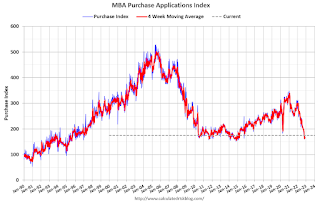by Calculated Risk on 11/23/2022 08:35:00 AM
Wednesday, November 23, 2022
Weekly Initial Unemployment Claims increase to 240,000
The DOL reported:
In the week ending November 19, the advance figure for seasonally adjusted initial claims was 240,000, an increase of 17,000 from the previous week's revised level. The previous week's level was revised up by 1,000 from 222,000 to 223,000. The 4-week moving average was 226,750, an increase of 5,500 from the previous week's revised average. The previous week's average was revised up by 250 from 221,000 to 221,250.The following graph shows the 4-week moving average of weekly claims since 1971.
emphasis added
 Click on graph for larger image.
Click on graph for larger image.The dashed line on the graph is the current 4-week average. The four-week average of weekly unemployment claims increased to 226,750.
The previous week was revised up.
Weekly claims were above the consensus forecast.
MBA: Mortgage Applications Increase in Latest Weekly Survey
by Calculated Risk on 11/23/2022 07:00:00 AM
From the MBA: Mortgage Applications Increase in Latest MBA Weekly Survey
Mortgage applications increased 2.2 percent from one week earlier, according to data from the Mortgage Bankers Association’s (MBA) Weekly Mortgage Applications Survey for the week ending November 18, 2022. Last week’s results include an adjustment for the observance of Veterans Day.
... The Refinance Index increased 2 percent from the previous week and was 86 percent lower than the same week one year ago. The seasonally adjusted Purchase Index increased 3 percent from one week earlier. The unadjusted Purchase Index increased 9 percent compared with the previous week and was 41 percent lower than the same week one year ago.
“The 30-year fixed-rate mortgage fell for the second week in a row to 6.67 percent and is now down almost 50 basis points from the recent peak of 7.16 percent one month ago,” said Joel Kan, MBA’s Vice President and Deputy Chief Economist. “The decrease in mortgage rates should improve the purchasing power of prospective homebuyers, who have been largely sidelined as mortgage rates have more than doubled in the past year. As a result of the drop in mortgage rates, both purchase and refinance applications picked up slightly last week. However, refinance activity is still more than 80 percent below last year’s pace.”
Added Kan, “With the decline in rates, the ARM share of applications also decreased to 8.8 percent of loans last week, down from the range of 10 and 12 percent during the past two months.”
...
The average contract interest rate for 30-year fixed-rate mortgages with conforming loan balances ($647,200 or less) decreased to 6.67 percent from 6.90 percent, with points increasing to 0.68 from 0.56 (including the origination fee) for 80 percent loan-to-value ratio (LTV) loans.
emphasis added
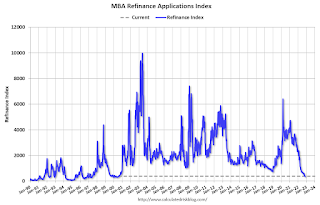 Click on graph for larger image.
Click on graph for larger image.The first graph shows the refinance index since 1990.
Note: Red is a four-week average (blue is weekly).
Tuesday, November 22, 2022
Wednesday: Unemployment Claims, Durable Goods, New Home Sales, FOMC Minutes
by Calculated Risk on 11/22/2022 08:50:00 PM
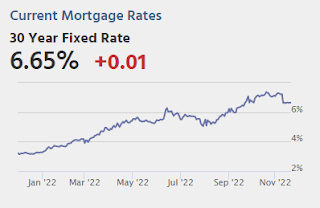
Wednesday:
• At 7:00 AM ET, The Mortgage Bankers Association (MBA) will release the results for the mortgage purchase applications index.
• At 8:30 AM, The initial weekly unemployment claims report will be released. The consensus is for 225 thousand initial claims, up from 222 thousand last week.
• At 8:30 AM, Durable Goods Orders for October from the Census Bureau. The consensus is for a 0.4% increase in durable goods orders.
• At 10:00 AM, New Home Sales for October from the Census Bureau. The consensus is for 570 thousand SAAR, down from 603 thousand in September.
• At 2:00 PM, FOMC Minutes, Meeting of November 1-2, 2022
November Vehicle Sales Forecast: Down slightly from October; Up 11% Year-over-year
by Calculated Risk on 11/22/2022 02:58:00 PM
From WardsAuto: November U.S. Light-Vehicle Sales to Slow from Prior Month; Still Point to Stronger Q4 (pay content). Brief excerpt:
Although heavily laden with pickups, inventory will rise again in November, lifting the prospects that the year ends on a strong note by overcoming challenges including myriad economy-related headwinds, high prices, potential railroad labor strike and others.
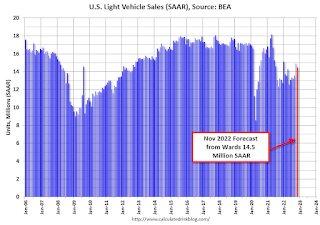 Click on graph for larger image.
Click on graph for larger image.This graph shows actual sales from the BEA (Blue), and Wards forecast for November (Red).
The Wards forecast of 14.5 million SAAR, would be down 3% from last month, but up 11% from a year ago (sales weakened in the second half of 2021, due to supply chain issues).
Black Knight: Mortgage Delinquency Rate Increased in October, Impacted by Hurricane
by Calculated Risk on 11/22/2022 12:43:00 PM
From Black Knight: Black Knight’s First Look: Prepayment Activity Hit Record Low in October as Rates Topped 7%; Mortgage Delinquencies Up 4.5% in First Signs of Hurricane Ian Impact
• Prepayments fell 16.5% to a single-month mortality (SMM) rate of 0.48%, well below the previous record of 0.55% and the lowest recorded since at least 2000 when Black Knight began reporting the metricAccording to Black Knight's First Look report, the percent of loans delinquent increased 4.5% in October compared to September and decreased 22% year-over-year.
• The national delinquency rate rose 4.5% in October to 2.91% – up 12 basis points since September – driven by a sharp 9.4% rise in 30-day delinquencies
• Florida led the jump in new early delinquencies (+19K) – with the state delinquency rate rising 53 basis points to 3.42% -- giving an initial indication of Hurricane Ian impact
• Loans 60 days past due ticked up 2.9% nationally, while those 90 or more days delinquent saw continued – if modest – improvement, inching down another 1.5% in October
• October’s 19.6K foreclosure starts represented a 7% increase that partly reversed September’s decline, but are still 55% below pre-pandemic levels
• Foreclosure starts were initiated on 4% of existing serious delinquencies in October, up slightly from September but still less than half the rate seen in the years leading up to the pandemic
• Active foreclosure inventory held steady as volumes have remained subdued in 2022 due to still historically low foreclosure start levels
emphasis added
Black Knight reported the U.S. mortgage delinquency rate (loans 30 or more days past due, but not in foreclosure) was 2.91% in October, down from 2.78% in September.
The percent of loans in the foreclosure process increased slightly in October at 0.35%, from 0.35% in September.
The number of delinquent properties, but not in foreclosure, is down 555,000 properties year-over-year, and the number of properties in the foreclosure process is up 48,000 properties year-over-year.
| Black Knight: Percent Loans Delinquent and in Foreclosure Process | ||||
|---|---|---|---|---|
| Oct 2022 | Sept 2022 | Oct 2021 | Oct 2020 | |
| Delinquent | 2.91% | 2.78% | 3.74% | 6.44% |
| In Foreclosure | 0.35% | 0.35% | 0.26% | 0.33% |
| Number of properties: | ||||
| Number of properties that are delinquent, but not in foreclosure: | 1,557,000 | 1,491,000 | 1,986,000 | 3,437,000 |
| Number of properties in foreclosure pre-sale inventory: | 186,000 | 185,000 | 138,000 | 178,000 |
| Total Properties | 1,743,000 | 1,677,000 | 2,125,000 | 3,616,000 |
Lawler: Likely "Dramatic shift" in Household Formation has "Major implications" for 2023
by Calculated Risk on 11/22/2022 09:17:00 AM
Today, in the Calculated Risk Real Estate Newsletter: Lawler: Likely "Dramatic shift" in Household Formation has "Major implications" for 2023
A brief excerpt:
Below is a chart showing the CPS/ASEC estimates of the % of 25-34 year olds living alone.There is much more in the article. You can subscribe at https://calculatedrisk.substack.com/
According to CPS/ASEC estimates, the % of adults (18+) living alone jumped to 14.9% in March 2022 from 14.4% in March 2021, and the % of households with just one member climbed to 28.9% from 28.2%. Both “living alone” measures (share of population and share of households) were at the highest levels ever recorded by the CPS/ASEC. The jump in one-person households was the major reason why the average household size as measured by the CPS/ASEC plunged to 2.50 in March 2022 (the lowest ever recorded) from 2.54 in March 2021. (Unrounded the average household size fell by .0341). In terms of share of total households, the one-person share increased the most for young adults (up to 39 years) and for 65-74 year olds. ...
... there is strong reason to believe that household growth is no longer getting the “boost” from behavioral changes as that suggested from March 2021 to March 2021. If that turns out to be true, then household growth is or will return back to growth more consistent with underlying population changes by age group, a development that would imply household growth over the next year of about half that apparently experienced from early 2021 to early 2022. Such a dramatic shift has major implications for projections of rent growth and home price growth next year.
Monday, November 21, 2022
Tuesday: Richmond Fed Mfg
by Calculated Risk on 11/21/2022 08:41:00 PM
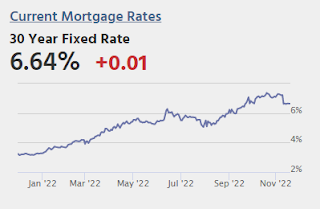
Mortgage rates made their biggest recent move (and their biggest single day move ever) 2 Thursday's ago after a key report showed inflation was lower than expected in October. There has been some jockeying for position among various mortgage lenders since then, but remarkably little change to the average 30yr fixed rate which is once again in the mid 6% range. ... [30 year fixed 6.64%]Tuesday:
emphasis added
• At 8:30 AM ET, Richmond Fed Survey of Manufacturing Activity for November.
MBA Survey: "Share of Mortgage Loans in Forbearance Increases Slightly to 0.70% in October"
by Calculated Risk on 11/21/2022 04:12:00 PM
Note: This is as of October 31st.
From the MBA: Share of Mortgage Loans in Forbearance Increases Slightly to 0.70% in October
The Mortgage Bankers Association’s (MBA) monthly Loan Monitoring Survey revealed that the total number of loans now in forbearance increased by 1 basis point from 0.69% of servicers’ portfolio volume in the prior month to 0.70% as of October 31, 2022. According to MBA’s estimate, 350,000 homeowners are in forbearance plans.
The share of Fannie Mae and Freddie Mac loans in forbearance increased 1 basis point to 0.31%. Ginnie Mae loans in forbearance increased 8 basis points to 1.41%, and the forbearance share for portfolio loans and private-label securities (PLS) declined 11 basis points to 1.03%.
“The overall share of loans in forbearance increased slightly in October, but it was a mixed bag by investor type. The forbearance rate for Ginnie Mae, Fannie Mae, and Freddie Mac loans increased, and there was a decline in portfolio and PLS loans in forbearance,” said Marina Walsh, CMB, MBA’s Vice President of Industry Analysis. “Several factors were behind the first monthly increase in forbearances in 29 months, including the effects of Hurricane Ian in the Southeast, the diminishing number of loans bought out of Ginnie Mae pools and placed in portfolio, and the fact that new forbearance requests have closely matched forbearance exits for the past three months.”
...
Added Walsh, “The overall share of loans that were current last month decreased 15 basis points to 95.70%, with 44 states reporting declines (not delinquent or in foreclosure). Florida, which was hit the hardest by Hurricane Ian, experienced a 49-basis-point drop in the share of loans that were current – the biggest decline of all states.”
emphasis added
 Click on graph for larger image.
Click on graph for larger image.This graph shows the percent of portfolio in forbearance by investor type over time.
The share of forbearance plans had been decreasing, although there was a slight increase in October. At the end of October, there were about 350,000 homeowners in forbearance plans.
Final Look at Local Housing Markets in October
by Calculated Risk on 11/21/2022 12:43:00 PM
Today, in the Calculated Risk Real Estate Newsletter: Final Look at Local Housing Markets in October
A brief excerpt:
The big story for October existing home sales was the sharp year-over-year (YoY) decline in sales. Another key story was that new listings were down further YoY in October as many potential sellers are locked into their current home (low mortgage rate). And active inventory increased sharply YoY.There is much more in the article. You can subscribe at https://calculatedrisk.substack.com/
This is the final look at local markets in October. I’m tracking about 35 local housing markets in the US. Some of the 35 markets are states, and some are metropolitan areas. I update these tables throughout each month as additional data is released.
Important: Closed sales in October were mostly for contracts signed in August and September. Rates increased to around 6% in September and that impacted closed sales in October. In October 30-year mortgage rates jumped to over 7%, and that will negatively impact closed sales in November and December.
...
And a table of October sales. In October, sales were down 28.6% YoY Not Seasonally Adjusted (NSA) for these markets. ... The NAR reported sales were down 29.5% NSA YoY in October.
Sales in some of the hottest markets are down around 40% YoY (all of California was down 37%), whereas in other markets, sales are only down in around 20% YoY.
...
More local data coming in December for activity in November! We should expect an even larger YoY sales decline in November and December due to the increase in mortgage rates in September and October.
Housing November 21st Weekly Update: Inventory Decreased Slightly Week-over-week
by Calculated Risk on 11/21/2022 08:57:00 AM
 Click on graph for larger image.
Click on graph for larger image.This inventory graph is courtesy of Altos Research.
1. The seasonal bottom (happened on March 4, 2022, for Altos) ✅
2. Inventory up year-over-year (happened on May 20, 2022, for Altos) ✅
3. Inventory up compared to 2020 (happened on October 7, 2022, for Altos) ✅
4. Inventory up compared to 2019 (currently down 35.2%).

